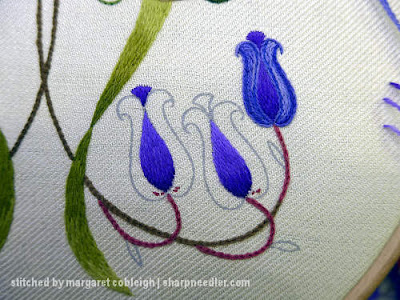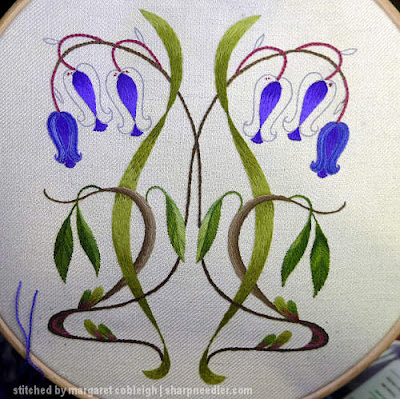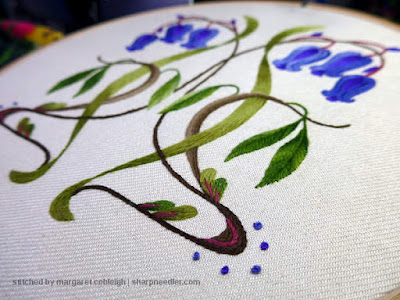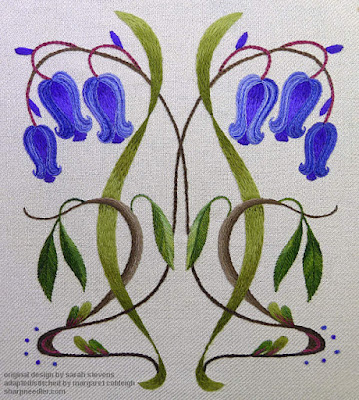The big leaves in the middle of the design are first.
Three shades of Daisies Rainforest green were used and progressed from dark on the outer leaves to lighter in the middle. I did not try to control the colour and let the variegation just happen. The first leaf on the right was embroidered first with closed fly. It looks great, but I decided I wanted to use multiple colours of the thread so closed fly wouldn't work. I switched to satin stitch with stem stitch down the middle, but that created a dilemma over what to do with the original leaf. I love the way the variegation looks and don't want to pick it out. It actually has the prettiest variegation of all the leaves. I'll have to think about it.
At any rate, the leaves turned out nicely. The Daisies threads are excellent to stitch with. There have been no problems with shredding and the variegation is subtle enough to not look garish, but still creates visual interest. Also, Daisies are colourfast and washable--as is Heathway--which is important for my purposes. By the way, Heathway is a wonderful thread as well. It's not hairy and doesn't shred. I have been stitching with approximately 20" (50 cm) lengths of both wools.
Finally, it was time for the flowers. It was hard, but I managed to save the purple for last!
The centres of the bluebells are embroidered in long and short with Heathway Violet. The small flowers on the ends are stitched with shades 7 and 9. The four larger flowers are filled with shades 5, 7, and 9.
The outer parts of the flowers are embroidered with Daisies Jacaranda in rows of stem stitch. I have four shades of Jacaranda and the two outer flowers are stitched with the darkest two. Lighter shades were used as I progressed towards the centre.
I occasionally did some colour control on the variegation. I didn't want strong splotches of colour, so if there were two lines next to each other that were too prominent, I took a contrasting shade and broke them up. The petals turned out a bit stripey, but they are interesting to look at. It's good having the colours vary and not just be a mass of solid colour.
The outer petals took quite a while to stitch. Rows of stem stitch are slow to embroider and changing colours makes them even slower, but here they are:
The piece was finished off with a mix of Heathway Violet and Daisies Jacaranda French knots at the bottom around the curves. I decided not to re-stitch the first big leaf and stem stitched down the middle covering the spine of the closed fly underneath. It now looks like the other leaves and has kept its beautiful variegation.
The project has turned out to have a coolly elegant colour palette. The Drab/Bark brown does a great job of anchoring everything. The browns and greens together give the impression of dark chocolate and mint.
I ended up having to wash the bluebells. Some sort of gunk got onto the edge of the fabric and wouldn't come out without washing. It was a good opportunity to see if the threads are indeed washable and colourfast. They absolutely are! The gunk washed out and the threads look great and there's no fuzziness. There's even a hint of sheen on the outer parts of the flowers. Both of these crewel wools are wonderful!
I had a blocking inspector:
A note about the cat: Suki loves clean linen fabric and likes to roll
around on it. She goes nuts with freshly washed linen bed sheets!. She
also likes wool especially a certain wool blanket. So, washing the
bluebells made her really happy. After the photo above was taken, she
walked all over the bluebells and tried to roll around on them.
Fortunately, the blocking pins were in the way and she was thwarted in
her rolling attempt! (The embroidery was dry, by the way, and there was
no damage.)
The piece (i.e., shading and variegation) changes with the light and viewing angle.The variegated threads of the flowers and leaves are the highlights as they should be, and the Heathways provide a beautiful elegant backdrop. I'm very pleased with how it turned out.
Here are a couple of views of the finished bluebells. The way the colours appear depending upon lighting conditions is great in person, but not so nice when taking photos! The second version does a better job of capturing the colour of the linen twill ground fabric. The greens are a bit more accurate in the first image.
This design was a lot of fun to stitch especially since I had no idea what it was going to look like when I started! I'm so grateful to Sarah Stevens of Melbury Hill for making her designs available as stamped linens. They are the embroidery equivalent of wonderful colouring book pages!










That has turned out beautifully well! Of course the advantage of embroidery "colouring in" over pencil colouring in, in these times, is that it takes rather longer!
ReplyDelete